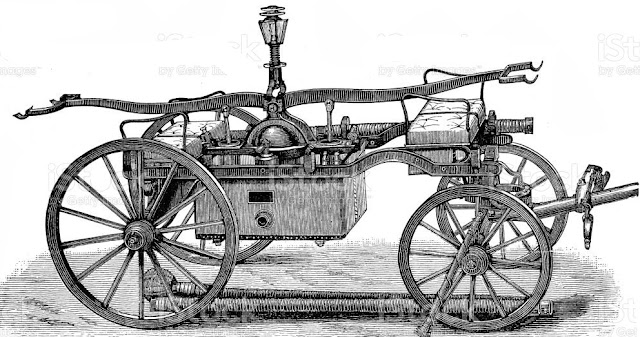At about 4 o'clock on Monday morning, one of the most destructive fires which have visited our city broke out in the new five-story brick block on South Water Street, corner of State Street. The accounts as to the origin of the fire are contradictory. It is supposed that it first broke out in Hale's chair factory on the upper floors of store № 43, the lower portion of which was occupied by Dix & Harris as a wholesale grocery store. Despite the exertions of the firemen, the flames rapidly spread and communicated with the adjoining store on the west occupied by Tuttle, Hibbard & Co., as a wholesale Hardware establishment, and the Stove warehouse was entirely destroyed.
 |
| The Fire Insurance Patrol № 6, 332 South Hoyne, Chicago, Illinois. |
A short time after the fire broke out, the east wall of Dix & Harris' store fell upon the adjoining dwelling, owned and occupied by Mrs. James Carney, completely crushing it, the family barely escaping with their lives. The building east of Mrs. Carney's was also considerably damaged. It was occupied by James O'Neil and Ostheim & Co., wholesale liquor dealers. A son of Mr. Joseph Ryan was buried in the ruins of Carney's dwelling and was only rescued after an hour's exertion by the large crowd assembled. The young man miraculously escaped with only slight injuries.
So intense was the heat that Mr. O'Neil's stone brewery, in the rear of his store, took fire and was extensively damaged, a considerable quantity of stock being destroyed. The American House, on the south side of the alley, also caught fire, but the flames were speedily extinguished. The Candle Factory on the alley, occupied by Mr. Johnson, was consumed. The rear of the new iron-front stores on Lake Street was greatly endangered and was on fire once to twice, but after great exertions were finally saved without material damage. The A.T. Spencer & Co.'s warehouse, on the north side of Water Street, was in imminent danger for a considerable time but escaped with a severe scorching. The store № 49, occupied as a wholesale grocery by Norton & Co., was several times on fire and considerably damaged by water. A large portion of their stock was removed, and all were more or less injured.
So far as could be learned from the parties themselves, the following is the amount of damage and insurance:
- Dix & Harris, loss $25,000; insured for $15,000.
- Tuttle, Hibbard & Co., loss $150,000; insured for $122,000.
- Hale &Co. lost about $8,000; No insurance.
- Jewett & Root, loss $50,000; insured for $25,000
- M.H. Norton & Co., loss $15,000; fully insured.
- Mrs. Carney, loss of $10,000; insured for $3,000.
- John O'Neil, loss of $500; No insurance.
- D. McIlroy, loss $500; No insurance.
- Ostheim & Sons, loss of about $500
- Mr. Doyle's barn burned, loss of $500; No insurance.
- Mr. Johnson, loss of $3,000; fully insured.
The five-story brick buildings were owned by John P. Atwater of Cincinnati and C. Bears of this city and were worth about $75,000. They were partially insured, but we could not learn the amount.
We regret to learn that Patrick Higgie, a brewer in the employ of Mr. O'Neil, was severely injured by the walls falling.
Turrill & Haven removed some of their stork of liquors, but they suffered minor damage.
Of the efforts of the firemen on this occasion, we shall have something to say hereafter. We were sorry to notice that many of them were too drunk to perform their duties or behave decorously. During the early part of the fire, they worked well, but being too freely supplied with liquor by imprudent friends, many behaved in a manner neither creditable to themselves nor the Department. Many complaints have reached us on this behalf, and several communications have been received, but a want of space compels us to defer our remarks for another day.
Compiled by Dr. Neil Gale, Ph.D.























